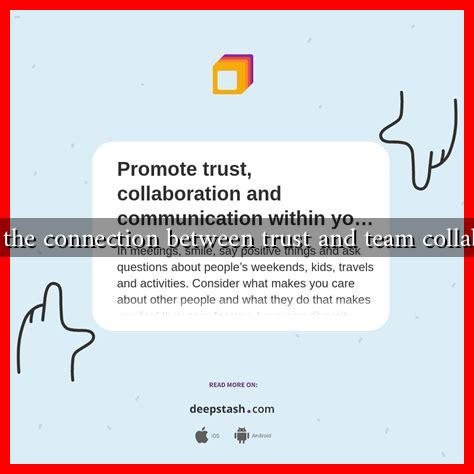-
Table of Contents
The Connection Between Trust and Team Collaboration
In today’s fast-paced and interconnected work environment, the ability to collaborate effectively within teams is more crucial than ever. At the heart of successful collaboration lies a fundamental element: trust. This article explores the intricate relationship between trust and team collaboration, highlighting its significance, the mechanisms through which it operates, and practical strategies to foster a trusting environment.
Understanding Trust in Teams
Trust can be defined as the firm belief in the reliability, truth, ability, or strength of someone or something. In a team context, trust manifests as a shared confidence among team members that they can rely on one another to fulfill their roles and responsibilities. According to a study by the Institute for Corporate Productivity, organizations with high levels of trust report 50% higher productivity and 76% higher engagement levels among employees.
The Role of Trust in Team Collaboration
Trust serves as the foundation for effective collaboration in several ways:
- Open Communication: Trust encourages team members to share ideas, feedback, and concerns without fear of judgment. This openness leads to more innovative solutions and a more inclusive environment.
- Risk-Taking: When team members trust each other, they are more willing to take risks, whether it’s proposing a bold idea or admitting a mistake. This willingness to take risks can lead to breakthroughs in projects.
- Conflict Resolution: Trust facilitates healthier conflict resolution. Teams that trust each other can engage in constructive debates, leading to better decision-making and problem-solving.
- Increased Accountability: In a trusting environment, team members hold each other accountable for their contributions, which enhances overall performance and commitment to team goals.
Case Studies: Trust in Action
Several organizations have successfully harnessed the power of trust to enhance team collaboration:
- Google: Google’s Project Aristotle revealed that psychological safety, a direct result of trust, is the most important factor in team effectiveness. Teams that felt safe to take risks and be vulnerable with one another were more successful.
- Pixar: At Pixar, trust is cultivated through a culture of open feedback and collaboration. The company encourages employees to share their ideas freely, leading to innovative films and a strong sense of community.
Statistics Highlighting the Importance of Trust
Research underscores the critical role of trust in team dynamics:
- A study by the American Psychological Association found that teams with high trust levels are 50% more likely to achieve their goals.
- According to a survey by Gallup, organizations with high employee engagement, which is closely tied to trust, outperform their competitors by 147% in earnings per share.
Strategies to Build Trust in Teams
Building trust within a team requires intentional effort. Here are some effective strategies:
- Encourage Transparency: Foster an environment where team members can share their thoughts and feelings openly.
- Promote Team-Building Activities: Engage in activities that strengthen relationships and build camaraderie among team members.
- Lead by Example: Leaders should model trustworthiness by being reliable, honest, and open in their communications.
- Provide Constructive Feedback: Create a culture where feedback is given and received positively, focusing on growth and improvement.
Conclusion
The connection between trust and team collaboration is undeniable. Trust not only enhances communication and accountability but also fosters an environment where innovation can thrive. Organizations that prioritize building trust within their teams are likely to see significant improvements in productivity, engagement, and overall success. By implementing strategies to cultivate trust, teams can unlock their full potential and achieve remarkable results.
For further reading on the importance of trust in the workplace, consider exploring resources from the American Psychological Association and Gallup.

